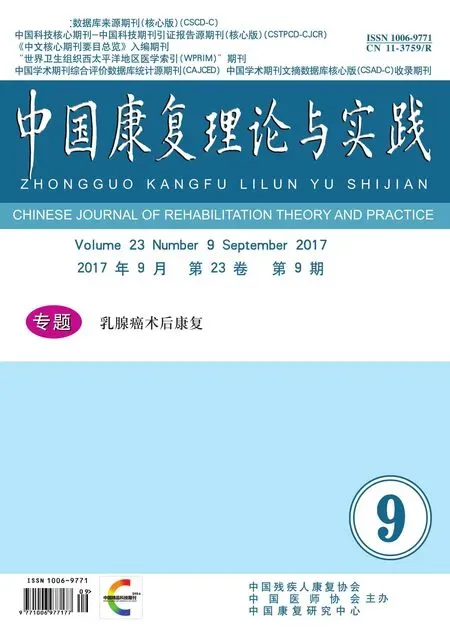帕金森病患者血浆和红细胞α-突触核蛋白寡聚体水平及临床意义①
梁杨,顾英,李晓红
帕金森病患者血浆和红细胞α-突触核蛋白寡聚体水平及临床意义①
梁杨,顾英,李晓红
目的 探讨帕金森病患者外周血浆及红细胞中α-突触核蛋白(α-syn)寡聚体含量对帕金森病诊断以及与病程、疾病严重程度的相关性。方法 2013年3月至2014年12月,采集30例帕金森病患者(患者组)及30例健康体检者(对照组)血液,采用酶联免疫吸附测定法检测血浆及红细胞中α-syn寡聚体含量。结果 对照组血浆及红细胞中α-syn寡聚体含量低于患者组(t>2.346,P<0.05);两组红细胞中α-syn寡聚体含量高于血浆中含量(t>2.242,P<0.05);患者组血浆及红细胞中α-syn寡聚体含量与病程、Hoehn-Yahr分期、帕金森病综合评分量表第3部分评分、帕金森病非运动症状问卷评分、简易精神状态检查评分均无相关性(P>0.05)。结论 帕金森病患者外周血浆及红细胞中α-syn寡聚体含量有助于帕金森病诊断,但不具有监测疾病进展价值。
帕金森病;α-突触核蛋白寡聚体;外周血;血浆;红细胞
帕金森病是中老年人常见退行性疾病之一,我国65岁以上人群总体患病率为1700/10万。随着病程进展,抗帕金森病药物疗效下降,药物副作用及并发症使患者病死率明显增高。帕金森病病理改变主要为中脑黑质致密部多巴胺神经元选择性变性、死亡,以及路易小体生成。α-突触核蛋白(alpha-synuclein,α-syn)为路易小体主要成分[1]。研究显示,帕金森病患者出现运动症状多处于病理损害中晚期,此时黑质致密部多巴胺神经元已丢失50%以上;而在黑质多巴胺神经元丢失之前,可在脊髓、嗅球等处发现α-syn聚集[2]。α-syn可通过血脑屏障进入外周血,故可在外周血中检测到α-syn水平异常。目前国内外对帕金森病患者外周血血浆及红细胞中α-syn寡聚体研究结果不一致[3-7],难以作为可靠的实验室指标加以应用。
1 资料和方法
1.1 一般资料
选取2013年3月至2014年12月就诊于大连市友谊医院神经内科,确诊为帕金森病的患者30例为患者组。其中男性16例,女性14例;年龄60~80岁,平均(70.5±7.18)岁;平均病程(4.3±1.25)年;Hoehn-Yahr(H-Y)分期Ⅰ~Ⅳ期;帕金森病综合评分量表第3部分(Unified Parkinson Disease Rating Scale,Part 3,UPDRS 3)评分平均(30.07±15.14);帕金森病非运动症状问卷(Non-Motor Symptom Quest,NMSQuest)评分平均(54.7±47.8);简易精神状态检查(Mini-Mental State Examinatlon,MMSE)评分平均(25.9±2.12)。
同期选取与患者组性别、年龄相匹配的健康体检者30例作为对照组。男性16例,女性14例;平均年龄(69.37±5.79)岁。
1.2 方法
两组禁食12 h以上,抽取空腹静脉血5 ml,置含有EDTA抗凝剂塑料管中,4℃、3000 r/min离心20 min,取上层血浆及红细胞分装于Eppendorf管中,-80℃超低温冰箱中保存备用。样本在采血后2 h内完成检测。
采用采酶联免疫吸附测定法,按试剂盒(上海博古生物科技有限公司)说明书对血浆及红细胞中α-syn寡聚体含量进行测定。
1.3 统计学分析
采用SPSS 20.0统计软件进行统计分析。计量资料以(xˉ±s)表示,采用独立样本t检验及配对样本t检验;相关性采用Pearson相关分析。显著性水平α=0.05。
2 结果
对照组血浆和红细胞中α-syn寡聚体含量均低于患者组(P<0.05);且两组红细胞中α-syn寡聚体含量均高于血浆含量(P<0.05)。见表1。
相关性分析显示,患者组血浆和红细胞中α-syn寡聚体含量与病程、H-Y分期、UPDRS3评分、NMSQuest评分、MMSE评分均无明显相关性(P>0.05)。见表2。

表1 两组血浆及红细胞中α-syn寡聚体含量(pg/ml)

表2 患者组血浆及红细胞中α-syn寡聚体含量与临床特征的相关性(n=30)
3 讨论
α-syn在脑内含量丰富[8],既维持突触正常功能,又与神经退行性疾病有关。α-syn在体内以无定型聚集物、寡聚体等多种结构形式存在,各种形式α-syn均有神经毒性,但寡聚体毒性大于单体[9-10]。
α-syn寡聚体神经毒性机制尚未明确,考虑原因如下。①α-syn正常、错误折叠及其寡聚化之间存在动态平衡,形成路易小体时可避免神经元损害;但这种保护作用短暂,当聚集成寡聚体降低多巴胺神经细胞中线粒体膜电位,导致多巴胺神经元死亡;②α-syn寡聚体病理性聚积可影响突触小泡膜的通透性及其循环,进而影响突触囊泡完整性和胞内多巴胺水平,导致多巴胺神经元死亡[11];③在人中脑神经元胶质细胞培养系统中,细胞外聚集α-syn单体和寡聚体,可激活小胶质细胞,生成大量氧自由基,导致多巴胺神经元死亡[12];④α-syn过表达可诱导线粒体功能失常,降低蛋白酶体活性,增加线粒体对凋亡刺激的敏感性[13]。
目前针对帕金森病患者α-syn寡聚体检测国内外已有较多报道。Mollenhauer[14]证实,脑脊液中异常聚集α-syn可作为帕金森病的诊断方法之一;但腰椎穿刺为有创操作,存在较多禁忌症,限制了其在临床中的应用。后研究发现,脑脊液中α-syn单体和寡聚体可透过血脑屏障进入外周血;获取外周血样本较脑脊液难度和创伤性均明显降低,故近10年来国内外多个研究对帕金森病患者外周血中α-syn单体及寡聚体水平进行研究,主要集中在血浆样本上,且未得到一致结论。近期国外有学者发现,帕金森病患者外周血红细胞样本α-syn水平的变化可能较血浆更加显著。
目前国内外对于外周血血浆中α-syn相关研究存在相互矛盾的结果。El-Agnaf等[3]发现帕金森病患者组α-syn含量显著高于对照组。李昕等[4]发现α-syn寡聚体在帕金森病患者血浆中含量显著高于对照组。但Foulds等[5]发现,患者组血浆中磷酸化α-syn显著高于对照组,但总α-syn和α-syn寡聚体水平与对照组无显著性差异。
本研究发现,患者组血浆中α-syn寡聚体含量高于对照组。原因除考虑与帕金森病患者脑内增多的α-syn寡聚体可通过血脑屏障进入外周血中外,还考虑如下因素:①尹娜等[6]发现,帕金森病患者外周血血浆促进α-syn形成α-syn寡聚体;②帕金森病患者血浆中氧化应激水平升高,而α-syn聚集除了受浓度影响外,还受氧化修饰影响,推测帕金森病患者可能因氧化修饰途径导致血浆α-syn寡聚。
本研究发现,患者组红细胞α-syn寡聚体含量高于对照组,且红细胞内含量高于血浆含量。这与Barbour等[7]研究结果一致。该团队认为,约99%的α-syn存在于红细胞,而血浆仅为0.1%。帕金森病患者外周血红细胞α-syn寡聚体含量升高,考虑原因为:①脑脊液中α-syn寡聚体透过血脑屏障进入外周血,绝大部分聚集在红细胞中;②研究发现,帕金森病患者黑质致密部铁水平增高,且铁可增加α-syn寡聚体聚集[15];红细胞内的血红蛋白含铁较高,某些环境下,红细胞内还存在较高浓度游离铁,可能为红细胞内α-syn聚集的原因。
本研究未发现患者组血浆和红细胞中α-syn寡聚体含量与病程、H-Y分期、UPDRS3评分、NMSQuest评分、MMSE评分相关。这与Parnetti等[16]的研究结果相同。α-syn的异常寡聚体更多作用于多巴胺神经元凋亡的促发阶段,而非多巴胺神经凋亡的结果。因此帕金森病患者外周血血浆及红细胞中α-syn寡聚体水平不具有监测病程进展的价值。
[1]Cersosimo MG,Benarroch EE.Neural control of the gastrointestinal tract:implications for Parkinson disease[J].Mov Disord,2008,23(8):1065-1075.
[2]George S,Rey NY,Reichenbach N,et al.α-synuclein:the long distance runner[J].Brain Pathol,2013,23(3):350-357.
[3]El-Agnaf OM,Salem SA,Paleologou KE,et al.Detection of oligomeric forms of alpha-synuclein protein in human plasma as a potential biomarker for Parkinson's disease[J].FASEB J,2006,20(3):419-425.
[4]李昕,杨巍巍,于顺,等.一种检测帕金森患者血浆促进α-突触核蛋白寡聚体形成能力的方法[J].首都医科大学学报,2013,34(6):830-834.
[5]Foulds PG,Mitchell JD,Parker A,et al.Phosphorylated alpha-synuclein can be detected in blood plasma and is potentially a useful biomarker for Parkinson's disease[J].FASEB J,2011,25(12):4127-4137.
[6]尹娜,陈予东,李昕,等.帕金森病患者血浆增强α-突触核蛋白寡聚体形成[J].首都医科大学学报,2013,34(6):840-843.
[7]Barbour R,Kling K,Anderson JP,et al.Red blood cells are the major source of alpha-synuclein in blood[J].Neurodegener Dis,2008,5(2):55-59.
[8]Claton DJ,George JM.Synucleins in synaptic plasticity and neurodegenerative disorders[J].J Neurosci Res,1999,58(1):120-129.
[9]李雁,殷娟娟,李昕.α-突触核蛋白寡聚体对多巴胺能神经细胞线粒体膜电位的影响[J].中国现代神经疾病杂志,2008,8(1):26-32.
[10]Ono K,Yamada M.Alpha-synuclein in blood and cerebrospinal fluid of patients with alpha-synucleinopathy[J].Rinsho Byori,2014,62(3):241-245.
[11]Landis GN,Tower J.Superoxide dismutase evolution and life span regulation[J].MechAgeing Dev,2005,126(3):365-379.
[12]Zhang W,Wang TG,Pei Z,et al.Aggregated alpha-synuclein activates microglia:a process leading to disease progression in Parkinson's disease[J].FASEB J,2005,19(6):533-542.
[13]Martin LJ,Pan Y,Price AC,et al.Parkinson's disease alpha-synuclein transgenic mice develop neuronal mitochondrial degeneration and cell death[J].J Neurosci,2006,26(1):41-50.
[14]Mollenhauer B.Quantification of α-synuclein in cerebrospinal fluid:How ideal is this biomarker for Parkinson's disease?[J].Parkinsonism Relat Disord,2014,20(1):S76-S79.
[15]Haacke EM,Cheng NY,House MJ,et al.Imaging iron stores in the brain using magnetic resonance imaging[J].Magn Reson Imaging,2005,23(1):1-25.
[16]Parnetti L,Chiasserini D,Bellomo G,et al.Cerebrospinal fluid Tau/α-synuclein ratio in Parkinson's disease and degenerative dementias[J].Mov Disord,2011,26(8):1428-1435.
Level ofAlpha-Synuclein Oligomers in Speripheral Blood Plasma and Red Blood Cells in Parkinson's Disease
LIANG Yang,GU Ying,LI Xiao-hong
Department of Neurology,Dalian Friendship Hospital,Dalian,Liaoning 116000,China
LI Xiao-hong.E-mail:xhlihh@126.com
Objective To investigate the level of alpha-synuclein(α-syn)oligomers in peripheral blood plasma and red blood cells(RBC)in patients with Parkinson's disease(PD),and the value of it for diagnosis and evaluation of PD.Methods From March,2013 to December,2014,peripheral blood samples were collected from 30 PD patients and 30 healthy coutrols,and the level of α-syn oligomers in plasma and RBC was detected with enzyme linked immunosorbent assay.Results The level of α-syn oligomers was less in both plasma and RBC in the controls than in the patients(t>2.346,P<0.05),and was more in RBC than in plasma in both the controls and the patients(t>2.242,P<0.05).The level of α-syn oligomers of patients did not correlate with their course,Hoehn-Yahr Stage,the scores of Unified Parkinson Disease Rating Scale Part 3,Non-Motor Symptom Quest and Mini-Mental State Examinatlon,both in plasma and RBC(P>0.05).Conclusion The level of α-syn oligomers in peripheral RBC and plasma may be helpful for diagnosis of PD,but less for the evaluation of the illness.
Parkinson's disease;alpha-synuclein oligomer;peripheral blood;plasma;red blood cells
R742.5
A
1006-9771(2017)09-1096-03
2016-12-27
2017-06-26)
10.3969/j.issn.1006-9771.2017.09.022
[本文著录格式] 梁杨,顾英,李晓红.帕金森病患者血浆和红细胞α-突触核蛋白寡聚体水平及临床意义[J].中国康复理论与实践,2017,23(9):1096-1098.
CITED AS:Liang Y,Gu Y,Li XH.Level of alpha-synuclein oligomers in speripheral blood plasma and red blood cells in Parkinson's disease[J].Zhongguo Kangfu Lilun Yu Shijian,2017,23(9):1096-1098.
大连市友谊医院,辽宁大连市116000。作者简介:梁杨(1988-),女,汉族,辽宁大连市人,硕士,医师,主要研究方向:帕金森病、脑血管病。通讯作者:李晓红。E-mail:xhlihh@126.com。

